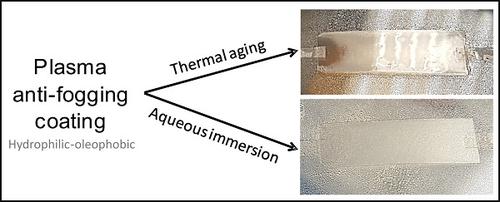当前位置:
X-MOL 学术
›
Plasma Processes Polym.
›
论文详情
Our official English website, www.x-mol.net, welcomes your
feedback! (Note: you will need to create a separate account there.)
Role of the surface chemistry of plasma polymer layers on their long‐term antifogging behavior
Plasma Processes and Polymers ( IF 2.9 ) Pub Date : 2020-01-13 , DOI: 10.1002/ppap.201900232 Thanh Hien Tran 1 , Dominique Debarnot 1 , José Ortiz 2 , Fabienne Poncin‐Epaillard 1
Plasma Processes and Polymers ( IF 2.9 ) Pub Date : 2020-01-13 , DOI: 10.1002/ppap.201900232 Thanh Hien Tran 1 , Dominique Debarnot 1 , José Ortiz 2 , Fabienne Poncin‐Epaillard 1
Affiliation

|
The long‐term antifogging capability of plasma coatings obtained from a hydrophilic precursor, such as 2‐(dimethylamino)ethyl methacrylate or acrylic acid, and a hydrophobic monomer, 1H,1H,2H‐perfluoro‐1‐decene (HDFD), deposited on polycarbonate is studied for two different agings. These films, when freshly prepared, show simultaneous hydrophilicity/oleophobicity for HDFD concentrations <50%. They fulfill antifogging criteria: low water contact angle (<20°), high hexadecane contact angle around 70° and preservation of optical transparency after water vapor contact. Depending on their chemical structure, only p‐AA‐co‐HDFD with 20–40% of HDFD retain their antifogging properties after thermal aging, while all of them are altered when dipped in hot water. p‐AA‐co‐HDFD is more efficient than p‐DAME‐co‐HDFD in reducing airborne contamination and improving long‐term antifogging performance.
中文翻译:

等离子体聚合物层的表面化学对其长期防雾行为的作用
从亲水性前体(例如甲基丙烯酸2-(二甲氨基)乙酯或丙烯酸,以及疏水性单体1H,1H,2H-全氟-1-癸烯(HDFD))获得的等离子涂层的长期防雾能力对聚碳酸酯进行了两种不同的老化研究。当新鲜制备时,这些薄膜对于HDFD浓度<50%表现出同时的亲水性/疏油性。它们满足防雾标准:低水接触角(<20°),高十六烷接触角(约70°)和与水蒸气接触后保持光学透明性。根据其化学结构,只有具有20-40%HDFD的p-AA-co-HDFD在热老化后才能保留其防雾性能,而当它们全部浸入热水中时,它们的防雾性能都会改变。
更新日期:2020-01-13
中文翻译:

等离子体聚合物层的表面化学对其长期防雾行为的作用
从亲水性前体(例如甲基丙烯酸2-(二甲氨基)乙酯或丙烯酸,以及疏水性单体1H,1H,2H-全氟-1-癸烯(HDFD))获得的等离子涂层的长期防雾能力对聚碳酸酯进行了两种不同的老化研究。当新鲜制备时,这些薄膜对于HDFD浓度<50%表现出同时的亲水性/疏油性。它们满足防雾标准:低水接触角(<20°),高十六烷接触角(约70°)和与水蒸气接触后保持光学透明性。根据其化学结构,只有具有20-40%HDFD的p-AA-co-HDFD在热老化后才能保留其防雾性能,而当它们全部浸入热水中时,它们的防雾性能都会改变。











































 京公网安备 11010802027423号
京公网安备 11010802027423号